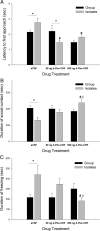Corticotropin-releasing factor receptor antagonism within the dorsal raphe nucleus reduces social anxiety-like behavior after early-life social isolation
- PMID: 19675229
- PMCID: PMC2772211
- DOI: 10.1523/JNEUROSCI.0854-09.2009
Corticotropin-releasing factor receptor antagonism within the dorsal raphe nucleus reduces social anxiety-like behavior after early-life social isolation
Abstract
Social isolation of rats during the early part of development increases social anxiety-like behavior in adulthood. Furthermore, early-life social isolation increases the levels of corticotropin-releasing factor (CRF) receptors in the serotonergic dorsal raphe nucleus (dRN) of adult rats. Interactions between serotonin and CRF systems are thought to mediate anxiety behavior. Therefore, we investigated the effects of CRF receptor antagonism within the dRN on social anxiety-like behavior after early-life social isolation. Male rats were reared in isolation or in groups from weaning until midadolescence, and rehoused in groups and allowed to develop into adulthood. Adult rats underwent surgery to implant a drug cannula into the dRN. After recovery from surgery and acclimation to the testing arena, rats were infused with vehicle or the CRF receptor antagonist d-Phe-CRF((12-41)) (50 or 500 ng) into the dRN before a social interaction test. Isolation-reared rats pretreated with vehicle exhibited increased social anxiety-like behavior compared with rats reared in groups. Pretreatment of the dRN with d-Phe-CRF((12-41)) significantly reduced social anxiety-like behaviors exhibited by isolation-reared rats. Overall, this study shows that early-life social stress results in heightened social anxiety-like behavior, which is reversed by CRF antagonism within the dRN. These data suggest that CRF receptor antagonists could provide a potential treatment of stress-related social anxiety.
Figures



Similar articles
-
Anxiety states induced by post-weaning social isolation are mediated by CRF receptors in the dorsal raphe nucleus.Brain Res Bull. 2011 May 30;85(3-4):117-22. doi: 10.1016/j.brainresbull.2011.03.003. Epub 2011 Mar 9. Brain Res Bull. 2011. PMID: 21396988 Free PMC article.
-
Early life social isolation alters corticotropin-releasing factor responses in adult rats.Neuroscience. 2009 Jan 23;158(2):845-55. doi: 10.1016/j.neuroscience.2008.10.036. Epub 2008 Oct 30. Neuroscience. 2009. PMID: 19010398 Free PMC article.
-
Corticotropin-releasing factor receptors in the dorsal raphe nucleus modulate social behavior in Syrian hamsters.Psychopharmacology (Berl). 2007 Oct;194(3):297-307. doi: 10.1007/s00213-007-0849-1. Epub 2007 Jun 21. Psychopharmacology (Berl). 2007. PMID: 17581742 Free PMC article.
-
Negative consequences of early-life adversity on substance use as mediated by corticotropin-releasing factor modulation of serotonin activity.Neurobiol Stress. 2018 Aug 7;9:29-39. doi: 10.1016/j.ynstr.2018.08.001. eCollection 2018 Nov. Neurobiol Stress. 2018. PMID: 30151419 Free PMC article. Review.
-
Corticotropin-releasing factor in the dorsal raphe nucleus: Linking stress coping and addiction.Brain Res. 2010 Feb 16;1314:29-37. doi: 10.1016/j.brainres.2009.09.100. Epub 2009 Oct 1. Brain Res. 2010. PMID: 19800322 Free PMC article. Review.
Cited by
-
Consequences of post-weaning social isolation on anxiety behavior and related neural circuits in rodents.Front Behav Neurosci. 2009 Aug 20;3:18. doi: 10.3389/neuro.08.018.2009. eCollection 2009. Front Behav Neurosci. 2009. PMID: 19738931 Free PMC article.
-
Translational relevance of rodent models of hypothalamic-pituitary-adrenal function and stressors in adolescence.Neurobiol Stress. 2016 Aug 29;6:31-43. doi: 10.1016/j.ynstr.2016.08.003. eCollection 2017 Feb. Neurobiol Stress. 2016. PMID: 28229107 Free PMC article. Review.
-
The role of dorsal raphe nucleus neuropeptides in reward and aversion.Front Behav Neurosci. 2025 Apr 9;19:1553470. doi: 10.3389/fnbeh.2025.1553470. eCollection 2025. Front Behav Neurosci. 2025. PMID: 40270681 Free PMC article. Review.
-
Post-weaning social isolation attenuates c-Fos expression in GABAergic interneurons in the basolateral amygdala of adult female rats.Physiol Behav. 2012 Dec 5;107(5):719-25. doi: 10.1016/j.physbeh.2012.05.007. Epub 2012 May 11. Physiol Behav. 2012. PMID: 22583860 Free PMC article.
-
Post-weaning Social Isolation in Male and Female Prairie Voles: Impacts on Central and Peripheral Immune System.Front Behav Neurosci. 2022 Jan 17;15:802569. doi: 10.3389/fnbeh.2021.802569. eCollection 2021. Front Behav Neurosci. 2022. PMID: 35111003 Free PMC article.
References
-
- Amat J, Tamblyn JP, Paul ED, Bland ST, Amat P, Foster AC, Watkins LR, Maier SF. Microinjection of urocortin 2 into the dorsal raphe nucleus activates serotonergic neurons and increases extracellular serotonin in the basolateral amygdala. Neuroscience. 2004;129:509–519. - PubMed
-
- Andersen SL. Trajectories of brain development: point of vulnerability or window of opportunity? Neurosci Biobehav Rev. 2003;27:3–18. - PubMed
-
- Bale TL. Sensitivity to stress: dysregulation of CRF pathways and disease development. Horm Behav. 2005;48:1–10. - PubMed
-
- Clark MS, McDevitt RA, Hoplight BJ, Neumaier JF. Chronic low dose ovine corticotropin releasing factor or urocortin II into the rostral dorsal raphe alters exploratory behavior and serotonergic gene expression in specific subregions of the dorsal raphe. Neuroscience. 2007;146:1888–1905. - PMC - PubMed
Publication types
MeSH terms
Substances
Grants and funding
LinkOut - more resources
Full Text Sources
Other Literature Sources
Medical
